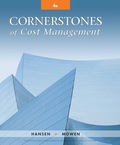
For each of the following situations, two scenarios are described, labeled A and B. Choose which scenario is descriptive of a setting corresponding to activity-based responsibility accounting and which is descriptive of financial-based responsibility accounting. Provide a brief commentary on the differences between the two systems for each situation, addressing the possible advantages of the activity-based view over the financial-based view.
Situation 1
A: The purchasing manager, receiving
B: The plant manager commended the manager of the Grinding Department for increasing his department’s machine utilization rates—and doing so without exceeding the department’s budget. The plant manager then asked other department managers to make an effort to obtain similar efficiency improvements.
Situation 2
A: Delivery mistakes had been reduced by 70 percent, saving over $40,000 per year. Furthermore, delivery time to customers had been cut by two days. According to company policy, the team responsible for the savings was given a bonus equal to 25 percent of the savings attributable to improving delivery quality. Company policy also provided a salary increase of 1 percent for every day saved in delivery time.
B: Bill Johnson, manager of the Product Development Department, was pleased with his department’s performance on the last quarter’s projects. They had managed to complete all projects under budget, virtually assuring Bill of a fat bonus, just in time to help with this year’s Christmas purchases.
Situation 3
A: “Harvey, don’t worry about the fact that your department is producing at only 70 percent capacity. Increasing your output would simply pile up inventory in front of the next production department. That would be costly for the organization as a whole. Sometimes, one department must reduce its performance so that the performance of the entire organization can improve.”
B: “Susan, I am concerned about the fact that your department’s performance measures have really dropped over the past quarter. Labor usage variances are unfavorable, and I also see that your machine utilization rates are down. Now, I know you are not a bottleneck department, but I get a lot of flack when my managers’ efficiency ratings drop.”
Situation 4
A: Colby was muttering to himself. He had just received last quarter’s budgetary performance report. Once again, he had managed to spend more than budgeted for both materials and labor. The real question now was how to improve his performance for the next quarter.
B: Great! Cycle time had been reduced and, at the same time, the number of defective products had been cut by 35 percent. Cutting the number of defects reduced production costs by more than planned. Trends were favorable for all three performance measures.
Situation 5
A: Cambry was furious. An across-the-board budget cut! “How can they expect me to provide the computer services required on less money? Management is convinced that costs are out of control, but I would like to know where—at least in my department!”
B: After a careful study of the Accounts Payable Department, it was discovered that 80 percent of an accounts payable clerk’s time was spent resolving discrepancies between the purchase order, receiving document, and the supplier’s invoice. Other activities such as recording and preparing checks consumed only 20 percent of a clerk’s time. A redesign of the procurement process eliminated virtually all discrepancies and produced significant cost savings.
Situation 6
A: Five years ago, the management of Breeann Products commissioned an outside engineering consulting firm to conduct a time-and-motion study so that labor efficiency standards could be developed and used in production. These labor efficiency standards are still in use today and are viewed by management as an important indicator of productive efficiency.
B: Janet was quite satisfied with this quarter’s labor performance. When compared with the same quarter of last year, labor productivity had increased by 23 percent. Most of the increase was due to a new assembly approach suggested by production line workers. She was also pleased to see that materials productivity had increased. The increase in materials productivity was attributed to reducing scrap because of improved quality.
Situation 7
A: “The system converts materials into products, not people at work stations. Therefore, process efficiency is more important than labor efficiency—but we also must pay particular attention to those who use the products we produce, whether inside or outside the firm.”
B: “I was quite happy to see a revenue increase of 15 percent over last year, especially when the budget called for a 10 percent increase. However, after reading the recent copy of our trade journal, I now wonder whether we are doing so well. I found out that the market expanded by 30 percent, and our leading competitor increased its sales by 40 percent.”
Trending nowThis is a popular solution!

Chapter 12 Solutions
EBK CORNERSTONES OF COST MANAGEMENT
- What was the company's net operating income for the year on these financial accounting question?arrow_forwardThe fiscal 2010 financial statements for Neptune, Inc report revenues of $14,892,615, net operating profit after tax of $987,625, net operating assets of $6,124,587. The fiscal 2009 balance sheet reports net operating assets of $5,995,633. What is Neptune s 2010 net operating profit margin?arrow_forwardPlease help with accounting question is solvearrow_forward
 Cornerstones of Cost Management (Cornerstones Ser...AccountingISBN:9781305970663Author:Don R. Hansen, Maryanne M. MowenPublisher:Cengage LearningPrinciples of Accounting Volume 2AccountingISBN:9781947172609Author:OpenStaxPublisher:OpenStax College
Cornerstones of Cost Management (Cornerstones Ser...AccountingISBN:9781305970663Author:Don R. Hansen, Maryanne M. MowenPublisher:Cengage LearningPrinciples of Accounting Volume 2AccountingISBN:9781947172609Author:OpenStaxPublisher:OpenStax College Managerial Accounting: The Cornerstone of Busines...AccountingISBN:9781337115773Author:Maryanne M. Mowen, Don R. Hansen, Dan L. HeitgerPublisher:Cengage Learning
Managerial Accounting: The Cornerstone of Busines...AccountingISBN:9781337115773Author:Maryanne M. Mowen, Don R. Hansen, Dan L. HeitgerPublisher:Cengage Learning


